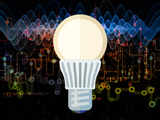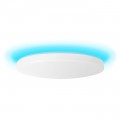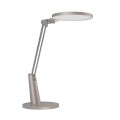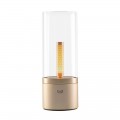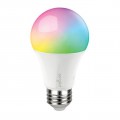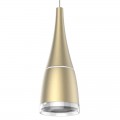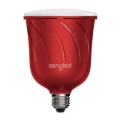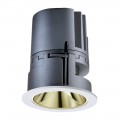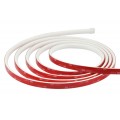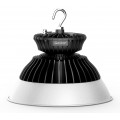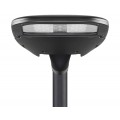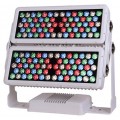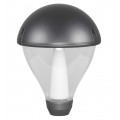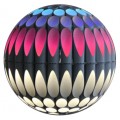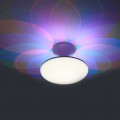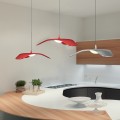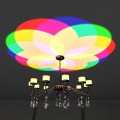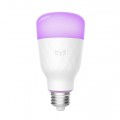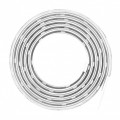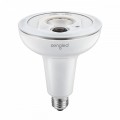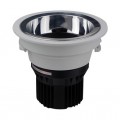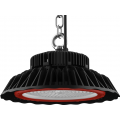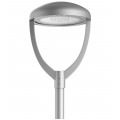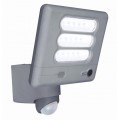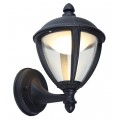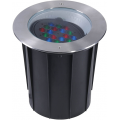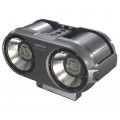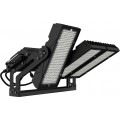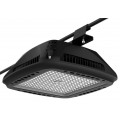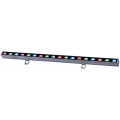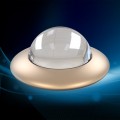Technically, LEDs require an internal DC voltage supply, acquired by converting the AC current supplied by the standard power line. The design of the driver circuit hence gets crucial in determining the performance of LED lamps. So, an AC sinusoidal voltage source would typically be rectified by a full-wave or half-wave rectifier into a rectified sinusoidal voltage source prior to coming into use. In this setting, the rectifying circuit simply draws power from the AC line when the instantaneous AC voltage is higher than the voltage across the bulk storage capacitor, causing a non-sinusoidal current signal that has high harmonic frequencies. Nonetheless, LEDs powered by AC power sources are a non-linear load. As a consequence of the non-linearity, LEDs powered by AC power sources are likely to have a lower power factor, and may also have a greater total harmonic distortion, than existing halogen or incandescent lighting devices. Despite the presence of saving a substantial amount of energy as compared with incandescent lamps, owing to the commercial electronic circuitry currently used, the incandescent lamp is able to have a higher input power factor from the AC main compared to LED lights. A load with low power factor draws more current over a load with a high power factor for the equivalent amount of useful power transferred, and thus results in higher resistive losses in wiring. Another undesirable consequence of power conversion involves total harmonic distortion (THD), and design factors that improve PF often also involve trimming down THD. It is accordingly advantageous to correct power factor for many types of load.
Power factor is described herein as the ratio of real power to apparent power. Real power is the capacity of the circuit to operate in a specific time frame, in contrast to apparent power is a product of the current and voltage of the circuit. Power factor is a basic way to figure out how much of the current contributes to real power in the load. For two loads that need the same level of real power, the load with the better power factor actually demands less current from the utility. A load with a 1.0 power factor requires the minimum amount of current from the utility. Power is lost in the system when the power factor is substantially below unity. Having a low power factor and increased distortion may contribute to increased energy costs, transmission losses, and/or damage to electrical equipment. Additional cost could be incurred in supply power as power factor correction at the utility supply may have to be provided leading to extra charges and wasted energy in the supply chain. A high power factor suggests that the reactive power drawn from the lamp is low and therefore the power conversion efficiency is high from the utility side to the lamp. As the amount of power required to drive an LED lighting device could possibly be less than to drive a halogen or incandescent lighting device generating a considerably similar amount of light, the overall cost of operating an LED luminaire using AC power may be the same as or more than the amount needed to drive the halogen or incandescent lighting device using the same AC power source. This means that, the power factor achieved by current LED products is somewhere around 30% lower than that of the incandescent lamps. The input current drawn from the LED lamps then contains a big amount of undesired harmonics. Distorted current waveforms often boost the harmonic energy content, and trim down the energy at the fundamental frequency. The existence of these harmonics denotes that portion of the power is wasted in the form of reactive power when power is transferred from the utility to the lamp.
A poor power factor may be caused by a phase difference between voltage and current. Power factor may also be deteriorated by distortion and harmonic content of the current. To deal with the power factor issue, it's quite common to couple a power factor correction (PFC) stage to the diode bridge rectifier, which improves the utilization of current drawn from the main AC line by shaping it to be more sinusoidal. Power factor correction is the process of fine-tuning the characteristics of electric loads that produce a power factor less than 1. Power factor control is considered desirable to mitigate the effects of high harmonic currents drawn from the mains supply line by non-linear loads such as rectifier and smoothing capacitor input stages. A power factor corrector can be advantageously employed to control the power source providing electrical energy to the LED string in order to acquire a power factor approaching unity. Design considerations that both increase PF and reduce THD may be collectively regarded as improving PF/THD performance. A PFC may be designed to offset the drawbacks in PF/THD performance by employing a controller that enables operating modes with diverse switch timing techniques in the AC to DC switching. These may include critical conduction mode (CrCM) and discontinuous conduction mode (DCM). A PFC controller may also respond to different loads and apply CrCM or DCM in accordance with changes in the load, and in this case is referred to as multi-mode. A power factor corrector generally comprises an error amplifier and a multiplier arranged to cooperate in an attempt to maintain a high power factor while controlling a power converter as a way to converge the input to the error amplifier towards a reference value.
Non-linear loads create harmonic currents aside from the original AC current. Addition of linear components including capacitors and inductors are not able to cancel these harmonic currents. To achieve a higher power factor and also to lower THD, active power factor correction (active PFC) can be used to control the amount of power drawn by a load, in order to obtain a power factor as close as possible to unity. In the majority of applications, the active PFC controls the input current of the load so that the current waveform is proportionate to the mains voltage waveform (a sine wave). Some types of active PFC are: Boost circuits, Buck circuits, and Buck-boost circuits, and may be implemented as single-stage or multi-stage. By way of example, a boost converter is frequently inserted between the bridge rectifier and the main input capacitors. The boost converter works to maintain a constant DC bus voltage on its output while drawing a current that is always in phase with and at the same frequency as the line voltage. Active PFC can produce a PFC of 0.99 (99%).












